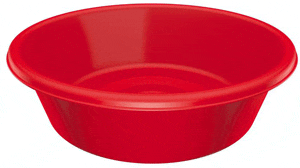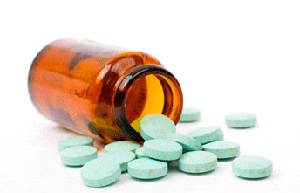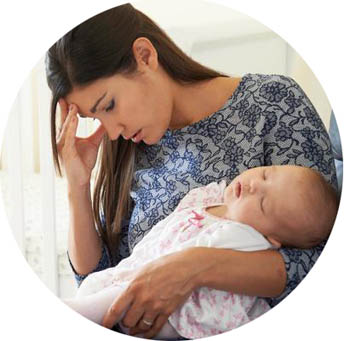Mother’s Care After Delivery
Vaginal discharge (lochia)
Expect some blood loss for up to six weeks after birth. There may even be some clots in the early days. If you soak more than one pad an hour, or pass clots the size of a golf ball or bigger, go to the nearest emergency room. The bleeding will decrease from heavy to light and from red to pink to white over one to two weeks. The lining of the uterus remains open until your flow stops, so you are more susceptible to infection. For this reason, do not have sex or use tampons until you stop having lochia. If you develop a fever (temperature above 38°C or 100.4° F, a foul smelling discharge or uterine tenderness, contact your health care provider.
Care after a vaginal delivery
The perineum is the area between your vagina and anus. Some perineal discomfort is normal after a vaginal birth. If you have stitches, you may feel a tightness or pulling sensation as your tissues heal. The discomfort will be more severe in the first few days after the baby is born, but will become less severe with each passing day. Until the vaginal bleeding stops, use your peri care bottle every time you use the toilet. Fill your squeeze bottle with fresh warm water. Squirt the water from front to back. Wipe, using a fresh tissue for each front to back stroke. You will be given a sitz bath if you have had an episiotomy or vaginal tear. Use your sitz bath three or four times a day for about 10 minutes at a time. Take the squeeze bottle and sitz bath home with you. At home, you may sit in the bathtub to soak if you find that more comfortable than the sitz bath.
When should I be concerned?
- Soaking a pad for 2-3 hours
- Passing clots that are the size of a golf ball or bigger
- Feeling light headed
- Feeling like you might faint
- Feeling short of breath
- Fever (>38°C or 100.4° F)
- Foul discharge
- Uterine tenderness
What is a sitz bath?
A sitz bath is a small plastic tub that fits on your toilet
Fill it with warm water and soak your bottom in it for 10 minutes four times a day
This will help your stitches heal
You may add some Epsom salts if you wish

| Vaginal Tear | What does it mean? |
|---|---|
| First degree | A very minor tear in the vaginal mucosa (inside the vagina) |
| Second degree | The most common kind of tear; it extends into the perineal muscle layer (in between the vagina and anus). |
| Third degree | A third degree tear is a tear that extends into the rectal sphincter. The rectal sphincter allows you to hold your gas in when you don’t want to pass gas. |
| Fourth degree | A tear that extends through the rectal sphincter and into the rectum. |
Third and fourth degree tears must be carefully repaired by an obstetrician. If you had one of these tears, make sure you keep your stools soft and don’t use enemas or suppositories until you are completely healed.
Care after a c-section
It takes longer to recover from a c-section than a vaginal birth. One or two days after birth, the large dressing covering your incision (cut) will be removed. You may shower once this dressing is removed. There is usually no need to apply another dressing. Avoid pressure on your incision until it is healed. A tube called a catheter will be placed into your bladder before surgery. This allows urine to drain out of the bladder and means you do not have to get out of bed to go to the bathroom. Usually your catheter is removed 8 to 12 hours after surgery. Wear self-sticking menstrual pads rather than a belt and pads once your catheter has been removed. Do not lift anything heavier than your baby until after you have had your postnatal check up.
Gas pains are common in the first few days after a c-section. You can help relieve gas pains by getting up and walking around as much as possible. Drink plenty of fluids and try gentle abdominal massage. Plan to have help for the first week or two when you return home as you will tire easily. Resume household tasks gradually and as you feel able.
Walking around will help get your bowels moving again and also help prevent the development of blood clots.
How to care for a c-section incision
- Keep incision clean and dry
- Let water and soap run over the incision in the shower
- don’t scrub at the incision
- don’t soak in a bathtub
- pat the incision dry with a towel
- dry with your hair dryer on a low setting
- If you are sent home with little tapes over your incision, remove these in the shower when baby is seven (7) days old
- If you are sent home with a little blue stitch, it needs to be removed. Speak to your health care provider
- Do not use any creams, powders or ointments on the incision
- Do not bind the incision
When should I be concerned?
- If your incision is red or swollen
- If there is pus leaking from the incision
- If you have foul discharge
- If you have a fever(>38 °C or 100.4 °F)
Uterine cramps
Expect some menstrual-like cramps in your abdomen and/or back in the first week. These cramps are caused by the uterus contracting back to its normal size. The cramps may be more severe when you have a full bladder (need to go pee) and when you are breastfeeding. Advil or Tylenol can be taken to help reduce your discomfort.

Self-medication program
Most women are able to take pain medication on their own after the birth of their baby. Your nurse will review your medication options and provide you with your own supply of pills. She will explain how to complete your self-medication record. Make sure that you return this record to your nurse before you leave the hospital.
If you have had a c-section, your nurse will provide you with pain medication during the first 24 hours after your delivery. After 24 hours, you will be able to participate in the self-medication program. You must be able to understand how to take your pain medication safely and record the time and how much medication you have taken.
Urinating (going pee)
After your delivery, your pelvic floor muscles may be weak, which can cause occasional bladder control problems. Doing pelvic floor exercises will improve your ability to control the urge to urinate. Empty your bladder at least every two or three hours.
Constipation
Eating lots of dietary fibre, whole grains, bran, cereal, fresh fruit and vegetables and drinking plenty of fluids can prevent constipation. Do pelvic tilts and perineal exercises to speed up the return of good muscle tone. Walk and remain active. Limit codeine and caffeinated beverages because they can contribute to constipation. If you do not have a bowel movement (go poo) within three days after birth, you may take a medication such as Colace or Senokot to help you go. Metamucil and Restoralax are also safe to use. Your pharmacist can provide you with information about laxatives and/or stool softeners if you need assistance.
Stool softeners that are safe in breastfeeding
- Docusate sodium (Colace)
- Sennosides (Senokot)
- Psyllium powder (Metamucil)
- Peg 3350 (Restoralax)
- Lots of fibre and fluids!
Hemorrhoids
Hemorrhoids are varicose veins of the rectum. They are common and can be uncomfortable before and after birth. They will shrink in time. Sitz baths and/or ice packs will provide some relief. Avoid constipation by increasing your fibre intake and drinking lots of fluids. You may also want to use a stool softener. Consult with your health care provider. Avoid standing for long periods of time. You may also use a hemorrhoid cream or Tucks according to the package description. You may want to sit on a donut cushion to make it more comfortable while the hemorrhoids heal.
Hemorroid treatments that are safe in breastfeeding
- Anusol
- Preparation H
- Tucks pads
Treat the constipation!

Breast care
If you are breastfeeding, wash your breasts with soap and water during your shower or bath. It is not necessary to wash your breasts before feeding. Breast milk has healing properties. Rub a small amount of breast milk on your nipples after nursing. Air dry your nipples before putting your bra back on. Avoid waterproof breast pads because they can reduce air circulation and can contribute to skin breakdown. If you would like an all-purpose nipple cream, speak to your health care provider for a prescription.
Bottle feeding?
It takes several weeks for the breasts to stop producing milk. Here are some suggestions to make you feel more comfortable:
- Wear a well-fitting bra
- Use ice packs for 20 minutes at a time
- Use pads to absorb leaking milk

Fatigue
It is normal to feel tired after the hard work and emotions of birth. Getting to sleep in the Mother and Baby Unit can also be a challenge. Try to nap whenever your baby goes to sleep. Turning off your phone may help to minimize disruptions. Please let us know if we can support you to encourage family and friends to keep visits short so you can get some rest.
Activity
Avoid heavy lifting in the early weeks after your delivery as your abdominal muscles are weak and less able to provide support for your back. When you go home, stair climbing, driving a car and going for walks are all activities that you can resume as long as you feel able to do so.

Emotions
Nearly all women experience some crying and mood swings in the first few weeks after birth. The blues usually last only a very short time. Try to get as much rest as possible. You might want to pump some milk so that someone else can do one feed for the baby. Limit your visitors and phone calls and accept all offers for household help. Try to arrange for some time for yourself and activities that you like to do. Even a brief walk around the block can sometimes help you feel refreshed. Talk to others about your feelings. Knowing that others often experience similar feelings is helpful.
Your partner will experience some ups and downs too. It is important to communicate your thoughts and feelings to each other. Try and find some time to spend with your partner.
If the blues do not improve in a few weeks and you are starting to feel depressed, discuss your feelings with your health care provider.
A small number of women do develop postpartum depression and it is important to get help to deal with this. Women who have had depression in the past are at greater risk for developing postpartum depression and should get prompt attention for persistent mood swings or feelings of depression.
If you’re still feeling blue a few weeks after birth or if you’re concerned about your mood at any point, speak to your health care provider!
Ways to improve Baby Blues
- Try to get as much rest as possible
- Pump some milk so that someone else can do one feed for the baby
- Limit your visitors and phone calls
- Accept all offers for household help
- Try to arrange for some time for yourself and activities that you like to do
- Talk to others about your feelings


Sexuality
After birth, it is not uncommon for women to feel too tired or sore for sexual activity. You may also notice other temporary problems such as reduced vaginal lubrication. This is common in women who are breastfeeding due to decreased estrogen levels. Spermicidal foam or cream or a water soluble lubricant (eg. Astroglide, not vaseline) around the vaginal opening may help. Try different positions until you find one that is comfortable for you. If these don’t help, speak to you health care provider about a vaginal estrogen cream.
Your pelvic floor muscles may be weak, leading to occasional bladder control problems. Void (go pee) frequently (every 2–3 hours). Pelvic floor exercises (Kegels) will help increase the tone in these muscles and improve bladder control. Your breasts may leak during sexual activity. Communication with your partner is important to help you both deal with these changes.
Even if you are breast-feeding and haven’t had your period yet, you can still get pregnant. Find out about your birth control options.
You must not rely on the information on this website as an alternative to medical advice from your doctor or other professional healthcare provider. If you have any specific questions about any medical matter you should consult your health care provider. If you think you may be suffering from any medical condition you should seek immediate medical attention. You should never delay seeking medical advice, disregard medical advice, or discontinue medical treatment because of information on this website.
